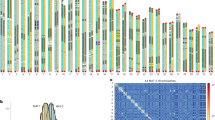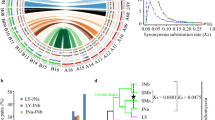Abstract
Arbuscular mycorrhizal (AM) fungi (Glomeromycota) are thought to be the oldest group of asexual multicellular organisms. They colonize the roots of most land plants, where they facilitate mineral uptake from the soil in exchange for plant-assimilated carbon1. Cells of AM fungi contain hundreds of nuclei. Unusual polymorphism of ribosomal DNA observed in individual spores of AM fungi inspired a hypothesis that heterokaryosis—that is, the coexistence of many dissimilar nuclei in cells—occurs throughout the AM fungal life history2,3. Here we report a genetic approach to test the hypothesis of heterokaryosis in AM fungi. Our study of the transmission of polymorphic genetic markers in natural isolates of Glomus etunicatum, coupled with direct amplification of rDNA from microdissected nuclei by polymerase chain reaction, supports the alternative hypothesis of homokaryosis, in which nuclei populating AM fungal individuals are genetically uniform. Intrasporal rDNA polymorphism contained in each nucleus signals a relaxation of concerted evolution4, a recombination-driven process that is responsible for homogenizing rDNA repeats5. Polyploid organization of glomeromycotan genomes could accommodate intranuclear rDNA polymorphism and buffer these apparently asexual organisms against the effects of accumulating mutations.
This is a preview of subscription content, access via your institution
Access options
Subscribe to this journal
Receive 51 print issues and online access
$199.00 per year
only $3.90 per issue
Buy this article
- Purchase on Springer Link
- Instant access to full article PDF
Prices may be subject to local taxes which are calculated during checkout




Similar content being viewed by others
References
Smith, S. E. & Read, D. J. Mycorrhizal Symbiosis (Academic, San Diego, 1997)
Kuhn, G., Hijri, M. & Sanders, I. R. Evidence for the evolution of multiple genomes in arbuscular mycorrhizal fungi. Nature 414, 745–748 (2001)
Bever, J. D. & Morton, J. Heritable variation and mechanisms of inheritance of spore shape within a population of Scutellospora pellucida, an arbuscular mycorrhizal fungus. Am. J. Bot. 86, 1209–1216 (1999)
Arnheim, N. et al. Molecular evidence for genetic exchanges among ribosomal genes on nonhomologous chromosomes in man and apes. Proc. Natl Acad. Sci. USA 77, 7323–7327 (1980)
Dover, G. Molecular drive: a cohesive mode of species evolution. Nature 299, 111–117 (1982)
Simon, L., Bousquet, J., Lévesque, R. C. & Lalonde, M. Origin and diversification of endomycorrhizal fungi and coincidence with vascular land plants. Nature 363, 67–69 (1993)
Redecker, D., Kodner, R. & Graham, L. E. Glomalean fungi from the Ordovician. Science 289, 1920–1921 (2000)
Remy, W., Taylor, T. N., Hass, H. & Kerp, H. Four hundred-million-year-old vesicular arbuscular mycorrhizae. Proc. Natl Acad. Sci. USA 91, 11841–11843 (1994)
Welch, D. M. & Meselson, M. Evidence for the evolution of bdelloid rotifers without sexual reproduction or genetic exchange. Science 288, 1211–1215 (2000)
Redecker, D., Hijri, M., Dulieu, H. & Sanders, I. R. Phylogenetic analysis of a dataset of fungal 5.8S rDNA sequences shows that highly divergent copies of internal transcribed spacers reported from Scutellospora castanea are of ascomycete origin. Fungal Genet. Biol. 28, 238–244 (1999)
Schüßler, A. Glomales SSU rRNA gene diversity. New Phytol. 144, 205–207 (1999)
Zhang, J. Z., Kumar, S. & Nei, M. Small-sample tests of episodic adaptive evolution—a case study of primate lysozymes. Mol. Biol. Evol. 14, 1335–1338 (1997)
Bécard, G. & Pfeffer, P. E. Status of nuclear division in arbuscular mycorrhizal fungi during in vitro development. Protoplasma 174, 62–68 (1993)
Giovannetti, M. et al. Genetic diversity of isolates of Glomus mosseae from different geographic areas detected by vegetative compatibility testing and biochemical and molecular analysis. Appl. Environ. Microbiol. 69, 616–624 (2003)
Klironomos, J. N. & Moutoglis, P. Colonization of nonmycorrhizal plants by mycorrhizal neighbours as influenced by the collembolan, Folsomia candida. Biol. Fertil. Soils 29, 277–281 (1999)
Kasuga, T., White, T. J. & Taylor, J. Estimation of nucleotide substitution rates in eurotiomycete fungi. Mol. Biol. Evol. 19, 2318–2324 (2002)
Wendel, J. F., Schnabel, A. & Seelanan, T. Bidirectional interlocus concerted evolution following allopolyploid speciation in cotton (Gossypium). Proc. Natl Acad. Sci. USA 92, 280–284 (1995)
Schlötterer, C. & Tautz, D. Chromosomal homogeneity of Drosophila ribosomal DNA arrays suggests intrachromosomal exchanges drive concerted evolution. Curr. Biol. 4, 777–783 (1994)
Arnheim, N., Treco, D., Taylor, B. & Eicher, E. M. Distribution of ribosomal gene length variants among mouse chromosomes. Proc. Natl Acad. Sci. USA 79, 4677–4680 (1982)
Birky, C. W. Heterozygosity, heteromorphy, and phylogenetic trees in asexual eukaryotes. Genetics 144, 427–437 (1996)
Hosny, M., Gianinazzi-Pearson, V. & Dulieu, H. Nuclear DNA content of 11 fungal species in Glomales. Genome 41, 422–428 (1998)
Otto, S. P. & Whitton, J. Polyploid incidence and evolution. Annu. Rev. Genet. 34, 401–437 (2000)
Mogie, M. & Ford, H. Sexual and asexual Taraxacum species. Biol. J. Linn. Soc. 35, 155–168 (1988)
Kondrashov, A. S. The asexual ploidy cycle and the origin of sex. Nature 370, 213–216 (1994)
Swofford, D. L. PAUP: phylogenetic analysis using parsimony (and other methods). Ver. 4 (Sinauer, Sunderland, MA, 1998).
Acknowledgements
We thank W. Pawlowski for help with the spore nuclei count; P. Bethke for advice on nuclei microdissection; D. Baker, T. Galagher, B. King, T. Lee and T. Szaro for technical assistance; J. A. Fortin for G. intraradices; D. Douds for the DC1 isolate of Ri T-DNA-transformed carrot roots developed by G. Bécard; and D. J. Read, T. Bruns, A. Burt and the members of the Taylor laboratory for comments on the manuscript. This work was supported by the Torrey Mesa Research Institute-Syngenta Biotechnology and the National Research Initiative Competitive Grants Program (NRICGP) of the US Department of Agriculture.
Author information
Authors and Affiliations
Corresponding author
Ethics declarations
Competing interests
The authors declare that they have no competing financial interests.
Supplementary information
Rights and permissions
About this article
Cite this article
Pawlowska, T., Taylor, J. Organization of genetic variation in individuals of arbuscular mycorrhizal fungi. Nature 427, 733–737 (2004). https://doi.org/10.1038/nature02290
Received:
Accepted:
Issue Date:
DOI: https://doi.org/10.1038/nature02290
This article is cited by
-
Arbuscular mycorrhizal fungi heterokaryons have two nuclear populations with distinct roles in host–plant interactions
Nature Microbiology (2023)
-
Varying strength of selection contributes to the intragenomic diversity of rRNA genes
Nature Communications (2022)
-
Evidence of non-tandemly repeated rDNAs and their intragenomic heterogeneity in Rhizophagus irregularis
Communications Biology (2018)
-
Divergence of Funneliformis mosseae populations over 20 years of laboratory cultivation, as revealed by vegetative incompatibility and molecular analysis
Mycorrhiza (2018)
-
RiPEIP1, a gene from the arbuscular mycorrhizal fungus Rhizophagus irregularis, is preferentially expressed in planta and may be involved in root colonization
Mycorrhiza (2016)
Comments
By submitting a comment you agree to abide by our Terms and Community Guidelines. If you find something abusive or that does not comply with our terms or guidelines please flag it as inappropriate.



